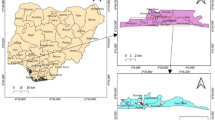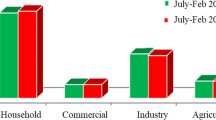Abstract
Demand planning for industrial’s electricity consumption is an important factor to efficiently plan the generation and distribution of power utilities. However, this can only be possible if the demand is predicted accurately. Recent advancement in adaptive neuro-fuzzy inference system aimed at mapping input to output for highly non-linear processes such as energy management field, provide reliable approach to forecast energy demand. Despite the wide range of applications and flexibility of adaptive neuro-fuzzy inference system, complexity of the rule base is featured with certain limitations associated with combinatorial explosion of rules, parameters and data. This paper proposes a hybrid procedure, subtractive clustering technique coupled with genetic algorithm, to develop adaptive neuro-fuzzy inference system. Genetic algorithm finds the optimum value of cluster radius which guaranteed the minimum number of rules and error. The empirical data regarding the industrial’s electricity demand in Iran from 1967 to 2011 are investigated to demonstrate the applicability and merits of the present method. The performance of hybrid approach is found to be better than that of conventional adaptive neuro-fuzzy inference system based on gird partitioning, fuzzy c-means, and subtractive clustering in terms of both accuracy and the number of rules.





Similar content being viewed by others
Explore related subjects
Discover the latest articles, news and stories from top researchers in related subjects.References
Akdemir B, Çetinkaya N (2012) Long-term load forecasting based on adaptive neural fuzzy inference system using real energy data. Energy Proc 14:794–799
Al-Ghandoor A, Samhouri M, Al-Hinti I, Jaber J, Al-Rawashdeh M (2012) Projection of future transport energy demand of Jordan using adaptive neuro-fuzzy technique. Energy 38:128–135
Aliyari M Sh, Teshnehlab M, Sedigh AK (2007) A novel hybrid learning algorithm for tuning ANFIS parameters using adaptive weighted PSO. In: Proceedings of the sixth IEEE international conference on fuzzy systems
Al-Shobaki S, Mohsen M (2008) Modeling and forecasting of electrical power demands for capacity planning. Energy Convers Manag 49(11):3367–3375
Bezdek JC (1981) Pattern recognition with fuzzy objective function algorithms. Plenum Press, New York
Cárdenas JJ, Romeral L, Garcia A, Andrade F (2012) Load forecasting framework of electricity consumptions for an intelligent energy management system in the user-side. Expert Syst Appl 39(5):5557–5565
Chen Y, Yang B, Abraham A, Peng L (2007) Automatic design of hierarchical Takagi–Sugeno type fuzzy systems using evolutionary algorithms. IEEE Trans Fuzzy Syst 15(3):385–397
Cheng CH, Wei LY (2010) One step-ahead ANFIS time series model for forecasting electricity loads. Optim Eng 2:303–317
Chiu S (1994) Fuzzy model identification based on cluster estimation. J Intell Fuzzy Syst 2(3):267–278
DeJong K (1988) Learning with genetic algorithms: an overview. Mach Learn 3:121–138
Demirli K, Cheng SX, Muthukumaran P (2003) Subtractive clustering based modeling of job sequencing with parametric search. Fuzzy Sets Syst 137:235–270
Demuth BH, Beale M, Hagan MT (2007) Neural network toolbox 5 user’s guide. The MathWorks Incorporation, Natick
Economic time series database (2012) Central bank of the Islamic Republic of Iran, http://www.tsd.cbi.ir/DisplayEn/Content.aspx
Ekonomou L (2010) Greek long-term energy consumption prediction using artificial neural networks. Energy 35(2):512–517
Fadare DA (2009) Modelling of solar energy potential in Nigeria using an artificial neural network model. Appl Energy 86(9):1410–1422
Fogel DB (1995) Evolutionary computation: toward a new philosophy of machine intelligence. IEEE Press, New York
Geem ZW, Roper WE (2009) Energy demand estimation of South Korea using artificial neural network. Energy Policy 37(10):4049–4054
Goldberg DE (1989) Genetic algorithms in search, optimization, and machine learning. Addison-Wesley, Reading
Ho WH, Tsai JT, Lin BT, Chou JH (2009) Adaptive network-based fuzzy inference system for prediction of surface roughness in end milling process using hybrid Taguchi-genetic learning algorithm. Expert Syst Appl 36:3216–3222
Hong WC (2009) Electric load forecasting by support vector model. Appl Math Model 33:2444–2454
Jang JSR (1993) ANFIS: adaptive network-based fuzzy inference systems. IEEE Trans Syst Man Cybern 23(3):665–685
Jang JSR (1996) Input selection for ANFIS Learning. In: Proceedings of IEEE international conference on fuzzy systems, New Orleans
Jang JSR, Gulley N (2000) Fuzzy logic toolbox: user’s guide. The Math Works Inc., Prentice-Hall
Kumar U, Jain VK (2010) Time series models (grey-Markov, grey model with rolling mechanism and singular spectrum analysis) to forecast energy consumption in India. Energy 35(4):1709–1716
Limanond T, Jomnonkwao S, Srikaew A (2011) Projection of future transport energy demand of Thailand. Energy Policy 33(5):2754–2763
Liu PY, Li HX (2004) Fuzzy neural network theory and application. World Scientific, Singapore, River Edge
MATLAB (2010) MATLAB Fuzzy logic toolbox reference manual, Version 7.10.0. The MathWorks Incorporation, Natick
Ministry of Energy (2013) Energy balance-sheet 2011. Energy report and statistics, Tehran, Iran [in Farsi]
Mollaiy-Berneti S (2013) A hybrid approach based on the combination of adaptive neuro-fuzzy inference system and imperialist competitive algorithm: oil flow rate of the wells prediction case study. Int J Comput Intell Syst 6(2):198–208
Oliveira MV, Schirru R (2009) Applying particle swarm optimization algorithm for tuning a neuro-fuzzy inference system for sensor monitoring. Prog Nucl Energy 51:177–183
Rissanen J (1978) Modeling by shortest data description. Automatica 14:465–471
Schwarz G (1978) Estimating the dimension of a model. Ann Stat 6:461–464
Tavanir holding company (2012) Statistical report on 45 years activities of Iran electric power industry, Deputy of human resources and research, management of information technology and statistics
Wang L, Yen J (1999) Extracting fuzzy rules for system modeling using a hybrid of genetic algorithms and Kalman filter. Fuzzy Sets Syst 101:353–362
Xia C, Wang J, McMenemy K (2010) Short, medium and long term load forecasting model and virtual load forecaster based on radial basis function neural networks. Int J Electr Power Energy Syst 32:743–750
Yager R, Filev D (1994) Generation of fuzzy rules by mountain clustering. J Intell Fuzzy Syst 2(3):209–219
Ying LC, Pan MC (2008) Using adaptive network based fuzzy inference system to forecast regional electricity loads. Energy Convers Manag 49(2):205–211
Zahedi G, Azizi S, Bahadori A, Elkamel A, Alwi SRW (2013) Electricity demand estimation using an adaptive neuro-fuzzy network: a case study from the Ontario province-Canada. Energy 49:323–328
Zhang X, Mao Y (2009) The relationship between energy consumption and economic growth in china based on ANFIS, In: International workshop on intelligent systems and applications, ISA, Wuhan
Zhang M, Mu H, Li G, Ning Y (2009) Forecasting the transport energy demand based on PLSR method in China. Energy 34(9):1396–1400
Author information
Authors and Affiliations
Corresponding author
Additional information
Communicated by V. Loia.
Rights and permissions
About this article
Cite this article
Mollaiy-Berneti, S. Optimal design of adaptive neuro-fuzzy inference system using genetic algorithm for electricity demand forecasting in Iranian industry. Soft Comput 20, 4897–4906 (2016). https://doi.org/10.1007/s00500-015-1777-3
Published:
Issue Date:
DOI: https://doi.org/10.1007/s00500-015-1777-3




